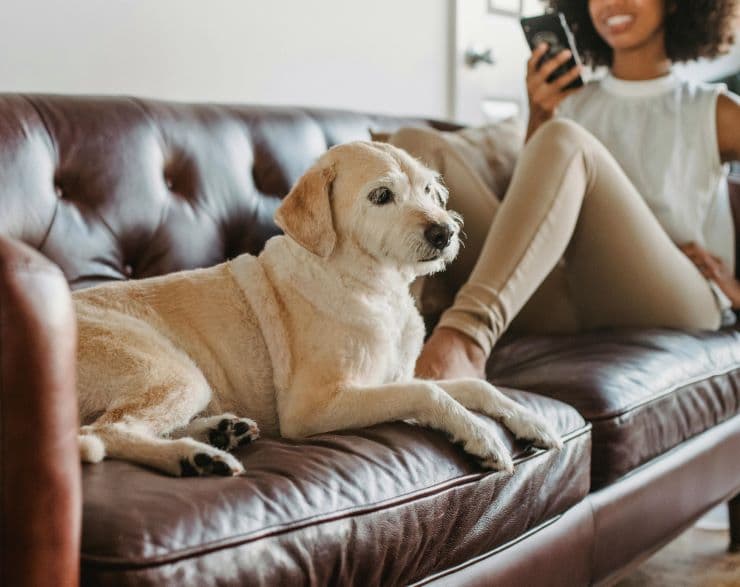The white picket fence and a dog in the yard are no longer ideal for many Americans. Nowadays, we’re more concerned with keeping our furry friends as close as possible, i.e. inside our homes.
This means our homes are not just places to eat and sleep, but spaces to create cherished memories with the little creatures we love most.
As integral members of our families, we need to do our best to show our pets we’ve put love and care into designing a home to suit their needs. A pet-friendly home.
By Amanda Braun
So how do you design an affordable pet-friendly home? Let's get to the bottom of it.
![]()

Photo Credit: Samson Katt/Pexels
A pet-friendly home is exactly what it sounds like - a home that's good for your pets. It reflects a deliberate effort to create an environment that caters to your four-legged friends and prioritizes their well-being.
Here, we consider the layout, furnishings, and general design so as not to compromise pet safety, comfort, and happiness.
There are many ways to be pet-friendly depending on your budget and home, but it most often concerns fabrics and dedicated play areas. Essentially, it’s a way to integrate your pet’s presence into the rhythm of household life without endangering them.
Did you know that even small adjustments to your living space can make or break your pet’s experience?
Take note of these 5 effective tips and the tail wags will never stop:
One of the first things you should consider when pet-proofing your home is using stain-resistant and durable fabrics.
In short, choose fabrics that are easy to clean, repel the inevitable spills that come with having pets, and can withstand pawing and scratching. For example, you can pick from some of the following materials:
Whatever you do, don’t go after silk or velvet because they're well-known hair magnets.
Photo Credit: Melike Benli/Pexels
Pets and plants rarely walk hand in hand. Most of the time, you have the pets chewing and gnawing on your plants or the plants triggering allergies for your pets. It takes a lot of trial and error to make this relationship harmonious.
But that’s not the biggest problem. Sometimes, your plants can even pose a threat to your furry friends, especially if they contain toxic materials. Chewing on these leaves may induce vomiting, stomachaches, seizures, and even death.
To be on the safe side, choose artificial plants that can maintain the aesthetic appeal of greenery and won’t be toxic to your pets if ingested. If possible, you can even install faux hanging plants that are out of reach for even the most athletic cats.
Whatever it is, learn your pet’s behavior around plants and do your best to keep them out of harm’s way.
Carpets are warm and comforting, but not the best idea when you have pets that shed. Pet hair, dander, and muddy paw prints can quickly turn a carpet into a breeding ground for allergens and bacteria.
Instead, consider other flooring options like hardwood, laminate, vinyl, or tile. These are not only much easier to clean but also cut the accumulation of pet messes.
Just keep in mind that the flooring must not be slippery! This is especially important for large and heavy dog breeds such as Great Dane or Mastiff. If slippery flooring is used, puppies of these breeds may develop deformed legs during their growth.
If you’re dead set on laying down carpets, be prepared to vacuum up to once per day or more during shedding season. Or, choose low-pile options that are less likely to trap pet hair and don’t need as much cleaning.
Photo Credit: Alexas_Fotos/Pixabay
Pets, especially puppies and kittens, have an instinct to chew. To ensure your home is safe from their tiny teeth, provide them with appropriate outlets to save your furniture from becoming a casualty.
We recommend investing in a variety of chew toys, especially if you have a dog. But keep in mind that flavored chew toys like pig’s ears may leave greasy stains on your floor after your dog’s done with them. It might be best to get rubber toys.
And if you have cats, get them a scratching post or a climbing tree to deter them from attacking your sofa.
Regardless of what you do, pet hair is a given. So, embrace this reality by strategically incorporating a color palette that complements your furry friend’s coat. Match your settee with your Siamese, if you please.
Light-colored furniture may camouflage light-colored pet hair, while dark tones hide dark-coated pets. Simple science, really. So, if you have dark hardwood floors and a white Persian, you’ll likely have white hairballs rolling around everywhere.
If you can’t upholster your furniture, consider using throws or slipcovers that are easy to clean and change. This will have you more relaxed without the constant concern about visible traces of fur.
Creating a pet-friendly home is no easy task, but it shouldn’t be daunting. In the end, you need to find the balance between aesthetics and functionality. That way, you'll ensure you can do everything in your power to make both you and your pet comfortable in your shared home.
Amanda Braun is a passionate yoga practitioner with a keen interest in writing about pets and home decoration. When she's not striking poses on the mat, she's busy crafting engaging content that combines her love for animals and interior design. With a knack for creating serene spaces and caring for furry friends, Amanda's writings reflect her dedication to holistic living and creating harmonious environments. Amanda's Facebook page.
You may also like:
We use cookies to offer you a better browsing experience, analyze site traffic, personalize content and ads.